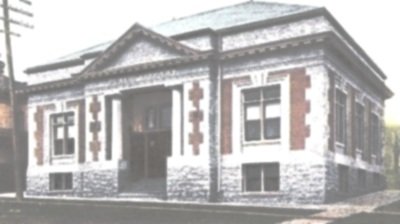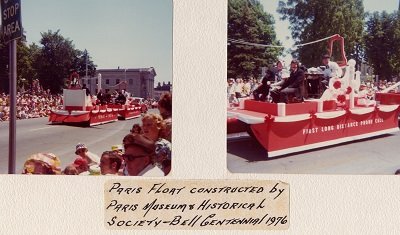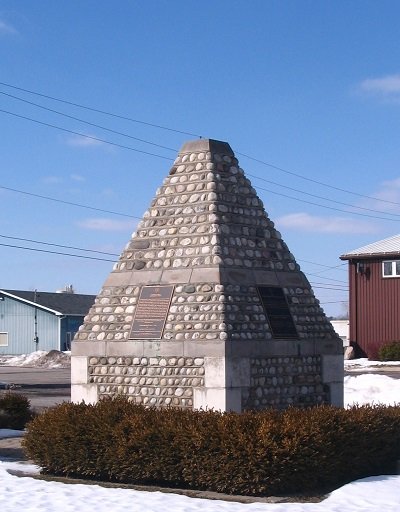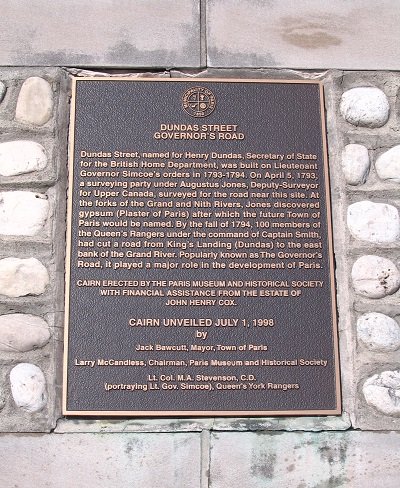
History of
The Paris Museum & Historical Society
History of the Paris Museum and Historical Society
Regionalization loomed over Paris in 1972. Late that year, the mayor and nine far-sighted volunteers gathered in Fred Bemrose's living room. Their purpose was to create the Paris Museum and Historical Society.
They feared the Paris library would soon lose its collection of historic documents; letters of the village founder Hiram Capron, pre-Confederation photos, original maps and irreplaceable records. They wanted to safeguard the town's heritage before it was lumped together with other archival material in a centralized regional library.
At the time, Paris was a tightly-knit rural community of 6,500 with a strong sense of its own history. Life was slower then. People read newspapers, wrote letters and met at church, the library and community events.
Bemrose, a salesman for Penman's Textiles, was joined that afternoon by Donald A. Smith, a respected local historian and principal of the high school, along with his wife Isobel; Jack Pickell editor of the Paris Star, along with his wife Muriel, Jackie Remus, an avid guardian of Paris's identity, a couple of town councillors and several members of the library board.
They purchased the entire collection from the library for $1.00. To help them get started, the library allowed the fledgling museum to use its lower level (now the children's department) for its collection.
The following is a portion of a speech made by John Bemrose on February 28, 2016, at the dedication of the Fred Bemrose Reading Room:
“Fred didn't just collect things, of course. He wrote articles, spoke to countless schoolchildren, took visitors on tours of the town, researched ancestors for anyone who asked, and put up displays, most notably his annual Remembrance Day display at the Legion. He seemed inexhaustible, yet by his early nineties dementia was starting to declare itself. Names and dates slipped away, to his endless frustration. Yet there good times, too. When I visited him in those last years, I would often find him in his bathrobe, in his basement workroom with its boxes piled to the ceiling, bent over some photo or document he'd forgotten he had, delighted with his discovery.
After his family and friends, the town was the love of his life. He was haunted not only by its past, but by the unforgettable presence of the place itself. "The rivers, the hills, how it all comes together," he said once, gesturing towards the forks, a little frustrated, perhaps, that he couldn't make himself clearer. I think he suspected that all the facts he exhumed, all the walks he went on, all the pictures he collected or took himself, could never entirely capture what he loved most deeply about Paris. But he kept trying -- for over forty years he kept trying. I think we can all feel fortunate that he did.”
The Paris Museum and Historical Society held its first general meeting and public exhibit the following year. Donald Smith, its president, brought along a brass bell used by three generations of school principals to summon students to classes. He told the 125 townsfolk in attendance the new museum would be a permanent, non-profit institution open to the people of Paris. It would encourage research into the history of the town and the surrounding area.
Bemrose, the museum's founding curator, was already busy acquiring antiques and artifacts to supplement the library's donation. He arranged to store them in the Public Utilities Commission (PUC) basement on Dundas Street.
As its first major project, the museum built a float for Brantford's 1974 "Thanks A Hundred" parade. It highlighted the 100th anniversary of the year Alexander Graham Bell invented the telephone.
In 1978, the board decided to open up PMHS to new members. Many of the initial members were archivists from the library. The fee was $2. Eight years later, it was raised to $5.
Before long, both the lower floor of the library and the PUC basement were bulging. Bemrose and his colleagues were inveterate collectors. Unbeknownst to the board, Bemrose often stored pieces of the museum's collection in his basement and friends' barns and garages. He was very protective of the town's treasures.
Over the next two decades, PMHS moved every few years to accommodate its ever-growing collection. In 1990, Bemrose convinced Paris council to let the museum display the town's historical artifacts in 10 lit glass cases surrounding the council chamber. The cases are still there, filled with photos and records documenting the past.
The next year he persuaded the board to erect a $40,000 cairn to commemorate the village's founders. It can still be seen at 61 Dundas Street East.
The display cases at town hall provided excellent political exposure and allowed the museum to expand beyond the library basement. But when the library donated another large swath of historical documents to the museum, more space had to be found. PMHS arranged with the library to have an office and storage space on the library's upper floor. This shone a public light on the wealth of information the museum had and attracted new volunteers and members.
Meanwhile, Public Utilities wanted its facility on Dundas Street back. On a cold November morning, a small group of volunteers moved all the shelves, boxes and artifacts to a new site on Woodslee Avenue. Shortly after everything was transferred, a fierce storm blew through Paris. It snowed all afternoon and into the night.
Three months later a pipe broke in the Dundas Street PUC basement that PMHS had recently vacated. By the time the leak was discovered, it was flooded to the rafters. Had the voluntary moving crew waited till spring, hundreds of the museum's irreplaceable artifacts would have been ruined.
In 1999, the town of Paris ceased to exist as an independent municipality. By that time, it had grown into a town of 12,310. Under regionalization, the Paris library became a branch of the County of Brant Library.
That same year, Fred Bemrose, then 83, retired as curator. Bob Hasler succeeded Bemrose as curator.
The early years of the 21st century were a period of experimentation and creativity, thanks in part to a $140,000 endowment from a generous benefactor. Many of the museum's traditions date back to that period: its annual volunteers' reception, its summer walking tours and its "show and tell" at which heirlooms are evaluated.
In 2004, hoping to consolidate everything in one place, the board decided to rent a building at 15 Curtis Avenue North. It hired a part-time curator, Lana Jobe, to organize its sprawling collection. It held training sessions for volunteers. It collaborated with outside organizations -- Beaver Magazine and CBC -- to tell local stories. It developed a logo and a Paris colouring book.
These initiatives ate into the endowment. By 2010, the rent on the Curtis Street building was sucking the non-profit organization dry. "We almost went bankrupt," Hasler recalled.
But a core of civic-minded Parisians refused to the let museum go under. They organized a capital campaign, went to the mayor and council for help and found a rent-free location at the Syl Apps Community Centre. "We started to pull together and work as a team," Hasler recalled. In 2011, the museum moved to its current location at 51 William Street.
A period of retrenchment began. PMHS began tracking its spending rigorously. It turned down projects and proposals it could not afford. In 2014, the board told Lana Jobe it could no longer pay her. After her departure, a plea was sent out to former volunteers to come back and help.
Gradually, the museum worked its way into the black. It developed a productive working relationship with the county. It culled its collection and created an easy-to-search digital record of its holdings. Thanks to several generous donors, it was able to invest in new technology and training.
In 2016, the museum opened a gift shop featuring crafts by local artisans. In 2017, it held its first community garage sale and found new ways to raise funds.
In 2017 PMHS marked its 45th anniversary. We look back on our development with pride and look forward to finding creative ways to showcase the heritage of Paris, forging partnerships with other local organizations, contributing to our community and welcoming many more visitors.
- Carol Goar, 2018

About the Paris Museum & Historical Society
The Paris Museum and Historical Society (PMHS) was founded in 1972 by a small group of heritage-minded residents. Today we are incorporated and are a registered charity. Our mission is to collect, preserve and make accessible the rich cultural heritage of Paris and surrounding area through exhibits and research materials. We are the only organization in the province to house an archive, a museum and a historical society, all under one roof.
We are affiliated with the Ontario Historical Society and belong to a number of other professional associations, including the Ontario Museum Association, The Brant Museum and Art Gallery Association, and the Archives Association of Ontario.
Our museum houses a research room, warehouse and storage facility, and an exhibition hall Our collection comprises over 40,000 objects and archival documents such as fine art, land documents, photographs, maps, family histories, extensive files on local buildings
and businesses and many other historical documents and artifacts. We have microfilm of local newspapers from the 1880s onward and bound original newspapers to 2010. Thanks to generous donations we have digitized our microfilm collection and are updating our collection methods.
We enjoy collaborating with a variety of community partners. We have contributed to the County of Brant Public Library digital online collection and take part in their county-wide history lectures. We also create historical displays for various County of Brant tourism events and for the Paris Agricultural Society. We provide historical research to various county departments and committees. Our outreach program includes presentations and tours for local seniors’ homes, local groups and social clubs. We host hundreds of local and international visitors to our museum every year.
Our organization is entirely run by volunteers who range in age from teenagers to seniors. In 2022 our volunteers logged may hours both onsite and in their homes and out in the community. We know that Paris’ heritage could very well be lost without their tireless efforts.







